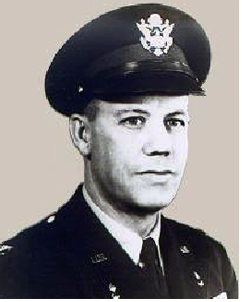Colonel
Carroll D. Hudson
 Colonel Carroll D. Hudson was
born on September 15, 1899 and served as an enlisted man in the Navy during World War I. He was commissioned in
1926 following graduation from Polytechnic High School in Los Angeles and Stanford University (1922).
Colonel Carroll D. Hudson was
born on September 15, 1899 and served as an enlisted man in the Navy during World War I. He was commissioned in
1926 following graduation from Polytechnic High School in Los Angeles and Stanford University (1922).
He spent three years with the Civilian Conservation Corps and was recalled to active duty as a major in 1940. His first monumental challenge came in 1941 as the first Commander of the Redstone Ordnance Plant (later redesignated Redstone Arsenal), a multi-million-dollar ordnance shell-loading and assembly plant located in Huntsville, Alabama.
He planned, constructed, and put the arsenal into operation. Within six months after breaking ground, production began. The arsenal perfected the technique of mass-producing tetrytol (a highly explosive binary mix used in certain bursters), boosters, and demolition blocks. At the most critical period of World War II, an average of 20 carloads of ammunition was shipped daily, involving the handling of 3,000 tons of war materials per day. Redstone produced 80 percent of the Army's chemical munitions during World War II.
After the war, he commanded Joliet Arsenal. In 1948, when Redstone Arsenal was designated as a center for rocket research, he returned to guide the installation through a facility construction program. During the Korean War, he directed the resumption of ammunition production and expedited the development of rockets and guided missiles. One of his last acts before departing Redstone Arsenal was to establish the Provisional Redstone Ordnance School. He retired in 1954 and died on June 4, 1992 in Newport Beach, California.